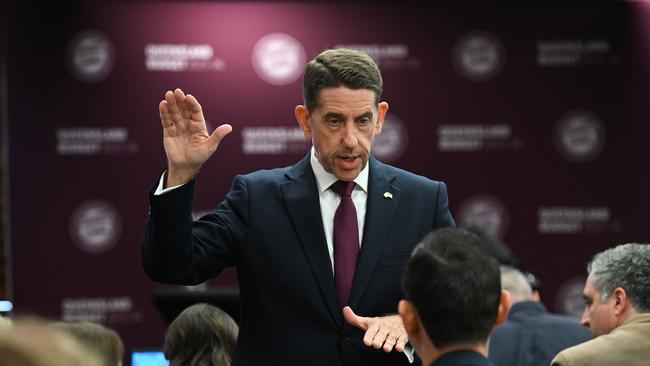Queensland budget: Coal hands state biggest surplus in Australian history
A crackdown on coal giants powered a record $12.31bn surplus, ahead of a fresh borrowing binge to fund its renewables transition.

A crackdown on coal giants powered a record $12.31bn surplus for the Palaszczuk government this financial year, ahead of the state embarking on a fresh borrowing binge to fund its transition to renewable energy.
Queensland Treasurer Cameron Dick on Tuesday produced an extraordinary turnaround of the state’s finances, flipping a predicted $1bn operating deficit for this financial year to the largest surplus of any state government in history.
The surplus, almost three times as large as WA’s, was generated by Mr Dick’s surprise introduction of three new tiers of coal royalty rates in last year’s budget, which delivered a $10bn boost to state coffers.
The huge coal royalty windfall will help bankroll $550 energy rebates for every Queensland household, totally wipe power bills for some pensioners, and make kindergarten free for all families from next year.
But the big spend on cost-of-living relief, ahead of the October 2024 state election, will see the state slip back into a $2.18bn deficit next year, with modest surpluses pencilled in over the forward estimates.
“It is not only the biggest (surplus) in Queensland history, it’s the biggest budget surplus ever recorded by any state or territory government,” Mr Dick said. “In fact, there are only four budget surpluses from the commonwealth that are bigger, all about 15 years or so ago.”

The royalty regime, which includes the highest taxing rates in the world, has drawn criticism from the resource industry, which claims it is threatening investment and jobs and may lead to the closure of mines.
Mr Dick’s centrepiece $8.2bn cost-of-living package will be doled out over the next year in the lead up to the 2024 election and comes as the Reserve Bank continues to hike interest rates to tame inflation.
Former commonwealth Treasury economist and director of Tulipwood Economics, Joe Branigan, said the power rebates had potential to add to inflationary pressures. “Even though money is allocated for power bills, it frees up money for the consumer to spend on something else,” he said.
But the Treasurer on Tuesday insisted the $1.5bn in energy rebates would not fuel inflation, which is expected to peak at 7.25 per cent this year, before dropping to 3.75 per cent in 2023-24.
Our budget will include funding to build an extra 500 social homes for Queenslanders in need.
— Annastacia Palaszczuk (@AnnastaciaMP) June 11, 2023
Mr Dick said about half of Queensland households would miss out on the commonwealth’s energy bill rebate, announced in May’s federal budget, but under the state scheme all 2.2 million households will receive at least $550 back on their power bills.
Queensland’s 60,000 concession card holders, such as pensioners and veterans, will receive an extra $150 off their energy bill.
“The net effect of that, for many households, is that they will not pay for electricity at all next financial year,” Mr Dick said.
Despite record windfalls, total debt – which includes the borrowings of state-owned corporations – will grow to $147.02bn by July 2027. Mr Dick said $10.65bn in equity injections would be put into government-owned corporations in the next four years and allocated to water, port and energy projects.
“We make no apology for using the strength of our government-owned corporations to build Queensland’s renewable energy future through our ($62bn) energy and jobs plan.”

On the government’s preferred measure of net debt, which excludes publicly owned companies, borrowings will increase more than sevenfold in the next four years, reaching $46.93bn by mid-2027. It remains considerably less than the $171.4bn Victoria’s Labor government is expected to rack up by mid-2027.
Queensland’s surge in borrowings comes after net debt for this financial year was revised down to $5.85bn, from $19.77bn predicted in last year’s budget.
Ratings agency S&P Global said Queensland’s debt levels “will remain consistent with AA+ rating level”.
“Further, fiscal pressure could eventuate because today’s budget adds billions of dollars to the state’s already large infrastructure program to fund its energy transition,” analyst Rebecca Hrvatin said.
“While the new royalty rates are positive for the rating, as they deliver billions of dollars of revenue, they may expose the state’s budget to substantial volatility over time, like other commodity-dependent peers.”
We're making kindy free for Queensland families. Saving families money and giving kids the best start for life - it doesn't get much better than that. #qldpol#qldbudgetpic.twitter.com/XbAZyNtXJs
— Cameron Dick (@camerondickqld) June 12, 2023
Mr Dick said borrowings would increase to fund the $89bn infrastructure program over the next four years, including $19bn for the renewable energy plan and an initial $1.9bn for the Brisbane 2032 Olympics.
Queensland’s capital spend per capita will continue to increase, overtaking that of both NSW and Victoria by 2024-25.
“Even as construction costs rise significantly across the country, continuing with these investments is a deliberate decision by our government,” Mr Dick said.
LNP Treasury spokesman David Janetzki said Mr Dick had pocketed an extra $60bn than he forecast in his first budget in late 2020 but problems with housing, health and youth crime persist.








To join the conversation, please log in. Don't have an account? Register
Join the conversation, you are commenting as Logout